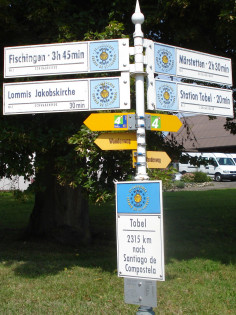On foot along the pilgrimage route through Switzerland
In the merry month of May my wife Vreni and fellow pilgrim Vera went on pilgrimage with me on this section. We started at the station Tobel-Affeltrangen. The Schwabenweg (Swabian Path) is well signposted here.
Soon after Tobel-Affeltrangen you will arrive at the Flüügenegg. Here we meet the Schwabenweg coming from the station.

The view widens after a small hill has been surmounted at Bettwiesen. In front of us lies Münchwilen.
Shortly before St. Margarethen stands this wayside shrine, which was originally a vineyard house and was converted in 1750.
The Margarethen Chapel in St. Margarethen before Münchwilen.
The present chapel dates from 1642 and was built in the transition period from Gothic to Renaissance. Typical for the 17th century is also the strong painting of the chapel, which is limited to a few colours.
In the pilgrims' vestibule, the walls are full of names, monograms and signs left behind by pilgrims of past centuries.
The left altar (not visible in the picture) is dedicated to the Fourteen Helpers in Need, the right one to St. Idda.
In the chapel there is also a pilgrim's stamp.
After the chapel the path leads to the small river Murg. Upstream, the path leads through Münchwilen, under the motorway to Sirnach.
At Gasthof Engel, a former pilgrims' hostel, the parish of Sirnach offers a simple meal to pilgrims with a pilgrim's pass. The inn can be reached in about 7 minutes from the pilgrims' path along the Murg.
Just follow the signpost, march towards the centre of the village (church).
In a stained glass window in the Martinskapelle in Oberwangen you can see the city coat of arms of Sirnach with the three scallops.
Along the Murg a resting place with a fireplace.
The path along the Murg is very romantic at the end. Unfortunately, a longer stretch of asphalt follows along the road through Wiezikon and the village of Wis. After that the path branches off to the hamlet of Aawil and then leads a little uphill through a forest.
There the St. Martin's Chapel of Oberwangen is already in front of us.
Inside the chapel we meet St. Martin and St. Elisabeth of Thuringia on the altarpieces on the left and St. Idda on the right.
From Oberwangen the path leads steadily uphill through a forest. Suddenly the
lies in front of us, like a bulwark at the end of the Murktal.
The monastery church was recently renovated and shines in its baroque splendour. The attached Idda Chapel contains the grave of the saint. It is a cenotaph (mock grave)
Idda in a halo with a stag above her funeral monument.